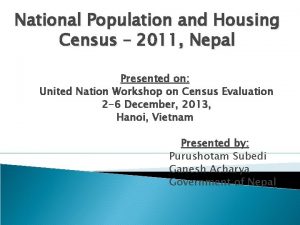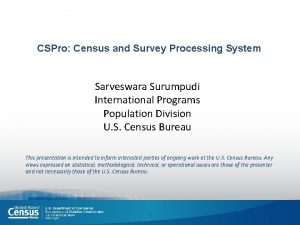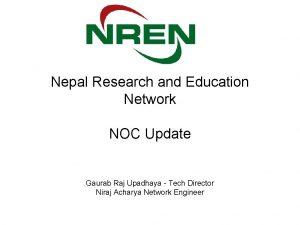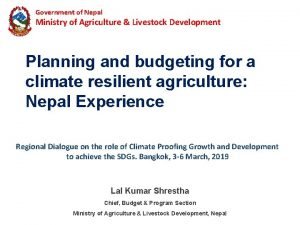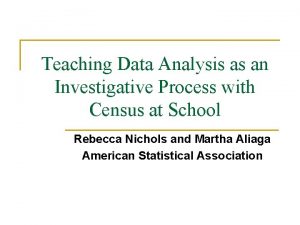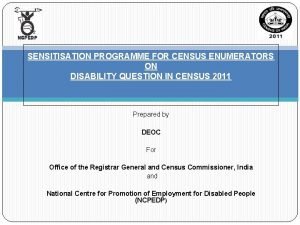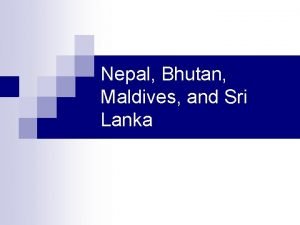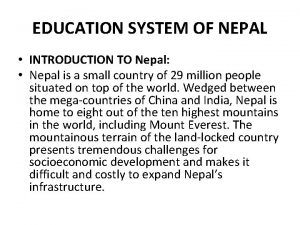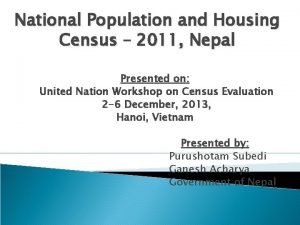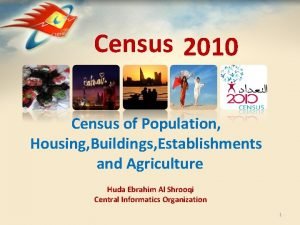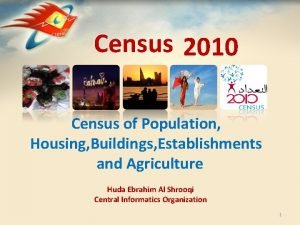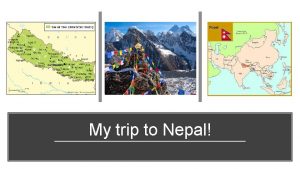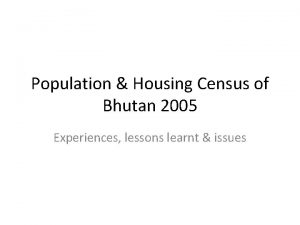Population and Housing Census of Nepal History Lessons














- Slides: 14

Population and Housing Census of Nepal: History, Lessons learned, and Initial planning for 2021 census Mahesh Kumar Subedi & Prakash Poudyal Central Bureau of Statistics (CBS) Kathmandu, Nepal United Nations Regional Workshop on the 2020 World Programme on Population and Housing Censuses: International Standards and Contemporary Technologies, 8 – 11 May 2018, Colombo, Sri Lanka

Nepal in Brief • A landlocked country in South Asia with geographical area 147, 181 square kilometers. • Altitude ranges from 70 meters to 8, 848 meters above sea level. • Population 26. 4 million (2011), 1. 35 % annual growth rate, and population density 180/square km. • 125 caste/ethnic groups, 123 languages. • Projected population 28. 8 million (2017) • The Constitution of Nepal (2015) has declared the country a Federal Democratic Republic of Nepal. • 7 Federal states, 753 local units - 460 Rural Municipalities and 273 Urban Municipalities

Map of Nepal

History of Population Census in Nepal • First population count was undertaken in 1911 in Nepal. • The last 2011 Population Census was the 11 th in the series population censuses • Four censuses before the 1952/54 census are known as “head counts”. • Modern census taking started from 1952/54 • After 1961, a census has been taken in every ten years. • Used ‘modified de jure’ method for counting population • Censuses up to 1961 were manually processed and tabulated. • Computerized processing and tabulations initiated from 1971 Census. • Data capturing process is still manual.

Population and Housing Census 2011 • The population census 2011 marks 100 years of population census taking in Nepal. • Follows 'Modified de' jure' method. • Preparation of EA maps began in 2009, two years before the census taking. • Household listing was done from 15 May 2011 for 2 weeks time. • Enumeration was done from 17 to 27 June 2011. • Census reference day was 22 June 2011. • Approximately 41, 000 field staff (supervisor enumerator ratio was 1: 4) • Data processing was done using CSPro. • Preliminary results with the total no. of households and sexwise pop by districts were released in Sep 2011.

NPHC 2011 Questionnaires Household Listing Form (including agriculture & livestock information) Schedule 1: Short form (100% enumeration) Schedule 2: Long form (Sample basis; 8: 1, household) The 2 questionnaires model: Short Form and Long Form was started in Nepal from 2001 Population Census.

Key lessons learned from previous census • Financial resources should be decided in time so that census operation modalities, selection of technology and methodology could be fixed in advance to avoid uncertainties. • Number of census questions should be optimally determined. More than 50 questions were asked in 2011 census. • Open ended questions should strictly be minimized. Caste/ethnicity, religion, language, second language were put in 2011 census as open ended questions. • New technology of data capturing, such as ICR, OMR or CAPI, be adopted for easing data collection, capturing and processing. • Enumeration area (EA) maps should be prepared in time and use extensively for reducing coverage errors in the census.

Broad Plan for 2021 Census

Timelines S. N. Key Activities/Milestones 2017 2018 2019 2020 2021 2022 PRE-CENSUS ACTIVITIES 1 Preparation of Census Project Document 2 Statistical Capacity Assessment 3 Census Budgeting 4 Establishing of Advisory Committees 5 Data User/Producer Consultation questionnaire content 6 Procurement 7 Selection of Technologies and Data Processing System

S. N. Timelines Key Activities/Milestones 2017 PRE-CENSUS ACTIVITIES Questionnaire Design (based on 8 multi-modal approach) 9 Cartographic activities 10 Pre-Test and Pilot Census Setting up Census Data Processing 11 Center and main Warehouse 12 Communication Campaign 13 Human resource management Printing of Questionnaires or 14 Acquisition/Procurement of Hardware 15 Development of Training Material 2018 2019 2020 2021 2022 16 Training of Enumerators/Field Staff 17 Distribution of Census Material 18 Post Enumeration Survey Planning

S. N. Timelines Key Activities/Milestones 2017 2018 2019 2020 2021 2022 CENSUS ENUMERATION 19 Household Listing Operation 20 Census Enumeration Complete 21 Post Enumeration Survey Complete Apr May 17 -27 Jun Sep

Timelines S. N. Key Activities/Milestones 2017 2018 2019 2020 2021 2022 POST CENSUS 22 Data Processing Jul-Sep 23 Data Analysis Jul-Dec 24 Release of Preliminary Results Sep 25 Dissemination of Final Results 26 Preparation of Monograph 27 Census Atlas 28 Nepal Census. Info and Federal State Census Info Mar. Sep Mar. Nov Mar. Apr

Way forward for next census • Prepare a detail plan- a Census Project Document • Strengthen institutional capacity as per federal set up • Decision on use of multi-model approach: paper questionnaire, CAPI, e. Census • Wide stakeholder consultation with data users, policy makers and academia • Decision on length of questionnaire and the key contents • Think of growing demands of disaggregated data and reporting of the various SDG indicators

THANK YOU!
 National population and housing census 2011
National population and housing census 2011 Matthias schleiden clipart
Matthias schleiden clipart Chapter test a chapter 4 population ecology answer key
Chapter test a chapter 4 population ecology answer key Population ecology section 1 population dynamics
Population ecology section 1 population dynamics Population ecology section 1 population dynamics
Population ecology section 1 population dynamics Chapter 4 section 1 population dynamics study guide
Chapter 4 section 1 population dynamics study guide What is cspro
What is cspro Ruth leiserowitz
Ruth leiserowitz Chapter 25 section 3 nepal and bhutan
Chapter 25 section 3 nepal and bhutan Noc update
Noc update Ministry of agriculture and livestock development
Ministry of agriculture and livestock development Quantitative variable examples
Quantitative variable examples Census disability question
Census disability question In those days caesar augustus issued a decree
In those days caesar augustus issued a decree Our census our future
Our census our future
